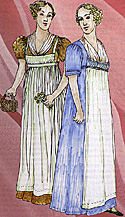
 Dress with draped tunic and turban styled bonnet, circa the early 1800s. (left)
Dress with draped tunic and turban styled bonnet, circa the early 1800s. (left)
The typical gown of the Consulate and the Early Empire featured a low neck, high waist, puffed sleeves, and slight train. The draped tunic decorated with embroidery and fringe as well as the turban-like bonnet were "eastern" motifs which Napoleon's Egyptian campaign helped to popularize. Such elements of romantic orientalism remained in vogue through the early 1820s.
 Day Dresses (right)
Day Dresses (right)
The day dresses of ordinary, middle-class English women sirca 1800. The low necklines are rendered more modest by tucking kerchiefs into the bodice. The fabric of the gowns is plain or printed cottons. Aprons, necessary to protect dresses during daily household chores, accommodated the fashionable high waists and were secured by either buttons or a bib front with straps. Average French women would have worn the same attire.
 Chemisette, circa 1800
Chemisette, circa 1800
This "fake blouse" had no sleeves and was left open at the sides. It could be easily worn under low cut dresses, especially in the cold weather or during daytime when more modest necklines were common. Chemisettes and detachable sleeves could be worn with different outfits, expanding the owner's wardrobe.
Color Illustrations of Women's Fashion
Back to One Excess: Women's Fashion
Back to Table of Contents -- Napoleon #5
© Copyright 1996 by Emperor's Press.
This article appears in MagWeb (Magazine Web) on the Internet World Wide Web.
The full text and graphics from other military history magazines and gaming magazines are available at http://www.magweb.com